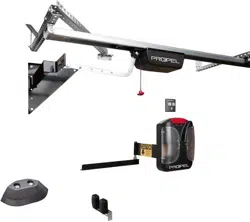Loading ...
Loading ...

e. The electrical contact is established after connecting the control housing to the C-rail. The two contacts supply
power (24V) to the motor carriage.
Caution: Do not operate the door until you have set the limit stops. Operating the door prior to setting the limits will
result in damage to your system, door, and/or building.
STEP 10 – Set the limit stops
a. Close the door by hand.
b. Slide the limit (with the V marking) all the way to the carriage motor until you hear a click.
c. Tighten the screw with a phillips screwdriver.
d. Open the door by hand.
e. Loosen the screw on the limit stop (with the H marking) using a phillips screwdriver and slide the limit stop all the
way back to the carriage motor until you hear a click
f. Tighten the screw with a phillips screwdriver.
STEP 11 - TEST THE OPERATOR
Program the remote transmitters and wireless wall station
In order to open, close or stop the opener using the transmitter, the opener has to “learn” the code first. The radio
code of the transmitter is transmitted to the receiver (inside the control housing). Plug in the power plug into the
power outlet
Learning the radio code
a. Press the learn button once on the control housing.
The LED (Radio) is solid.
b. Press a desired transmitter button. The LED (Radio) flashes briefly.
If the LED (Radio) lights up for a second, the transmitter has been learned.
Operating the opener with the wall station: Opening, closing, and stopping the door
a. To open and close, press the button once. The door opens or closes depending on the starting position. The light
switches off automatically after 180 seconds.
b. To stop, press the button during the open/close procedure once. The next press of the button causes the door to
move back to its respective position.
c. The door arm and boot should not contact the jamb when the door opens. Adjust the limit stops if necessary.
Learning the forces of the door
When the opener is initially connected to the main supply, the opener lights blink. This indicates that the opener is
ready to learn the forces of the door.
After the completion of two full cycles (four door movements) the lights will stop blinking.The opener controller
automatically detects the required force each time the door moves. If an obstacle (i.e. a person or a vehicle) blocks
the door’s movement, in the closing direction: the door will reverse automatically; in the opening direction: the door
will stop.
a. Press the Reset button on the control housing until the “Status” LED turns off. The LED “Status” blinks while being
pressed.
b. Release the Reset button.
The light and the LED “Status” blink.
c. Operate the door two full cycles. The light stays on. The learning process is completed.
The light will turn off after approx. 180 seconds.
Test the emergency release
a. Close the door.
b. Attach the provided chain to the emergency release cored.
c. Pull on the emergency release chain once.
When functioning correctly, the carriage is now unlocked and the door can now be moved by hand.
Test the obstacle detection function
After the force has been learned, the obstacle detection must be checked. The door must change directions after
contacting a 1“ (25,4 mm) high object placed against the door jamb.
a. Open the door with the opener
b. Place an approx 1” object (a short 2x4 piece of wood will do) on the floor at the opposite door jamb
c. Close the door with the opener. When the door contacts the object, it must stop immediately and reverse
completely. If the door does not reverse,check the basic settings of the limit stop, see chapter “Installation”. In all
other cases, the opener is defective and must be repaired or replaced. Consult your qualified dealer for advice.
Test the photo eyes function
a. Close the door with the opener. Hold a 6“ high white object during the closing procedure in between the photo eyes
to disrupt the infrared beam. The door must stop immediately and then reverse entirely. The photo eyes are
functioning properly, if the LED lights of both photo eyes are solid
b. If the door does not stop, check the following:
• if the housing of the photo eyes are dirty,
• whether transmitter and receiver are correctly aligned with each other,
• whether the cables are damaged or loose.
STEP 14 – Install Cinchers
The cincher plate is mounted to the jamb above a door girt (crossmember) about 4-5 feet above the floor.
3
Loading ...
